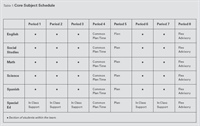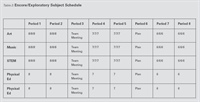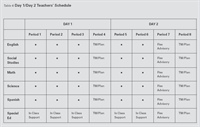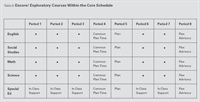Professional collaboration, an integral part of the middle school concept, is a prerequisite for effective interdisciplinary instruction. When teachers have the opportunity to collaborate during the school day, they are able to develop interdisciplinary, multidisciplinary, and integrated concept-based instruction that meets the needs of their students.
To promote the collaboration needed to establish relationships and address the concepts, content, and skills within interdisciplinary instruction, schools must provide common planning time for teachers within the schedule.
As middle grades educators consider establishing a schedule that provides common planning time and supports interdisciplinary instruction, they should first review the school’s mission/vision statement. This statement forms the basis for decisions not only about the schedule, but about the instruction that occurs within the schedule. The mission/vision statement should express a commitment to teacher collaboration as well as integrated or interdisciplinary approaches to instruction. It provides a foundation for the schedule.
Frameworks for Collaboration

Table 1: Core Subject Schedule
Next, school leaders must determine an overall framework for the schedule. This framework requires a group of teachers to share a group of students at the same times during the day. It also requires a designated period for common planning time.
Table 1 illustrates a schedule that provides common planning time for a core team consisting of an English, social studies, math, science, foreign language, and special education teacher who have the same students for periods 1–3 and 6–7 daily. In addition, the team is responsible for orchestrating the flex advisory period (period 8). Flex advisory provides time for supplemental instruction, guidance activities, and response to intervention. It also provides opportunities for teams to work on interdisciplinary lessons or units.

Table 2: Encore/Exploratory Subject Schedule
In addition to providing common planning time for core interdisciplinary teams, the schedule should provide an opportunity for the encore/exploratory teachers to collaborate. As illustrated in Table 2, all students in a grade level are scheduled for encore at the same time. A student enrolls in a trimester of art, music, and STEM in one encore period and physical education in the other.
If possible, members of the core and encore teams can attend the other’s planning time so that cross-school integration or interdisciplinary instruction can occur. One example might be the STEM teacher meeting with the math and science teacher to plan a special unit or to provide ongoing content and skill integration.
If they are not represented in the core common plan time meeting, encore members need to be involved through school e-mail communication about themes/topics/skills being taught. Combined core and encore meetings could be an agenda item at faculty meetings as well.
Program of Studies
The program of studies is a clear statement that lists the subjects or courses to be included in the core interdisciplinary cohort. These content area teachers attend a common planning period as illustrated in period 4 of Table 1.
A defined listing of courses should also be identified for the encore/exploratory program. Students take these courses while core teachers attend team meetings or have personal planning time. Encore/exploratory teachers are scheduled for collaboration as indicated in period 3 of Table 2.
Blueprint

Table 3: Blueprint Draft of a Master Schedule
The blueprint (Table 3) is a preliminary draft of a master schedule. Common planning time for the core teachers occurs when students from a particular grade level are in encore classes. Because all students are in core classes during periods 3 and 6, the encore team can collaborate in period 3. At that time, they choose interdisciplinary connections within the encore curriculum or between the core and the encore curricula.
The blueprint is but a sample and reflects the framework selected. In this case, the framework is a traditional 8-period day. Care must be taken, however, to avoid nonconsecutive core periods to provide the most possibilities for flexibility.
Additional Framework and Blueprint

Table 4: Day 1/Day 2 Teachers’ Schedule
A day 1/day 2 schedule provides another possible framework to create common planning time. In the day 1/day 2 framework, classes meet for 90 minutes on an alternate day basis. The 90-minute planning period is divided to allow a 45-minute team meeting and a 45-minute personal planning time (Table 4).
Opportunities for integration and interdisciplinary instruction may be greater when class periods are 90 minutes in length. Further, thematic interdisciplinary units can be more completely addressed when the flex/advisory period meets for 90 minutes every other day.

Table 5: Encore/Exploratory Courses Within the Core Schedule
A variation of the schedule presented in Table 5 involves technology for one semester and art for the other semester, replacing Spanish 1 in the core portion of the schedule. This option increases opportunities for curriculum integration and/or thematic interdisciplinary units for a semester each.
Summary
Schedules are key to support the professional collaboration needed for interdisciplinary instruction. Therefore, common planning periods must be clearly defined and within the contractual day for teachers. Although core and encore teams traditionally meet separately, it is possible to create options during the day for interchange.
Since common planning time is an integral part of the teachers’ workday, guidelines are needed for the effective use of this time. Teachers need a procedure to regularly assess their use of common planning time to promote the relationship between planning and delivery of instruction.
Elliot Y. Merenbloom, an educational consultant, is a veteran teacher, school counselor, middle school principal, and former director of middle school instruction in Baltimore County, Maryland.
elliot@merenbloom.com
Barbara A. Kalina, a long-time teacher, consultant, and author in Batavia, Illinois, is an active board member of the Association of Illinois Middle-Grade Schools.
bkal911@comcast.net
Frequent AMLE conference presenters, they are the authors of Making Creative Schedules Work in Middle and High Schools and Creative Scheduling for Diverse Populations in Middle and High Schools.
Published in AMLE Magazine, May 2015.